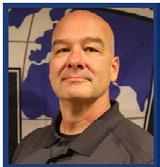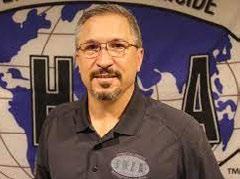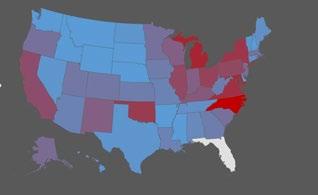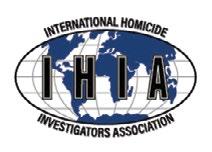INVESTIGATIVE QUARTERLY
A Publication by the International Homicide Investigators Association (IHIA)
www.IHIA.org
PRESIDENT’S MESSAGE
Lieutenant Paul Belli (Retired) Sacramento County Sheriff’s Office
Dear Colleagues, Members and Sponsors,
We have had an exciting first half of 2023. We have had the opportunity to share training, experiences, and best practices with over 800 course attendees in the United States, Columbia, and the United Kingdom. The second half of the year remains just as busy with upcoming courses in Nashville, TN hosted by TBI and ROCIC, Bogota Columbia with ICITAP, and the annual Symposium in Oklahoma City with the FBI, OSBI and OKCPD.
Planning for the 2023 Symposium is complete with an outstanding agenda and presenters. Paul Butler will be joining us again this year as our opening day MC and first presenter. The Tuesday leadership breakout has grown tremendously and is quickly filling up so please get registered. We will update our website and provide updates as they happen. Please continue to check www.ihia.org for the latest information. Our exhibitors have once again stepped up to show support for what each of you do daily to keep our communities safe around the globe. We enjoy a great relationship with our sponsors and exhibitors, some of them will have the opportunity to provide real world case studies during the general session.
On behalf of the Association Board, I want to thank you for your membership and support. We will continue to strive to provide resources, guidance, and training to each of you and our profession.
President Paul Belli International Homicide Investigators Association
EDITION: JULY 2023
WHAT’S INSIDE THE IQ:
• Letter from President Paul Belli
• 2023 Symposium Flyer
• 2023 Symposium Leadership Agenda/ Flyer
• 2023 Symposium Agenda
• From the desk of The IHIA Association Manager Steve Lewis
• International Director – David GaylorUK Figg article
• Leadership Article – Member at Large, David Eddy - Heroism

• Article: 911 Calls in Mysterious Disappearances of Children –Indicators of Veracity and Deception
• Article: A Geofence Search Warrant Must Particularly Describe – Update
• Article: Are People Allowed to Livestream their contacts with Law Enforcement
• Article: Arson Homicides 2010-2020
• Piquerism in Overkill Homicides
• DNA & Genealogy Summit Flyer
• Upcoming Training & Marketing Opportunities
The IHIA is the world’s largest and fastest growing organization of homicide and death investigation professionals. The non-profit organization represents the largest network of homicide professionals and practitioners ever assembled. The IHIA has representatives in every U.S. state and nations on six continents.
For membership information, visit: www.ihia.org/Membership

JULY 2023 | PAGE 1
™



JULY 2023 | PAGE 2 IHIA IHIA 29th ANNUAL INTERNATIONAL SYMPOSIUM August 6 - 11, 2023 OKLAHOMA CITY Member Early Bird Before 4/30/2023 $515 Member $545 Non-Member $595 REGISTER HERE BOOK HOTEL
8:00 AM – 10:00 AM
Tuesday, August 8, 2023

8:00 AM – 5:00 PM
Jeffrey Martin, J.D., C.F.V.T. Consultant, DSI
Learn more about Jeff Martin here
Consulting
Pros and Cons of Relying on In-House Subject Matter Experts
This session will cover some of the errors that result from investigators asking in-house subject matter experts (SMEs) such as TASER or defensive tactics instructors to analyze officer conduct. Contributing factors, including a lack of investigator and SME training in the foundations of forensic video analysis and/or human factors, as well as question formation, will be covered. The emphasis will be on the use of video evidence in use-of-force investigations, with interactive discussion as to how to best use video evidence in relation to interviews and other recommendations.
10:00 AM – 12:00 PM

Dr. Chris Fuzie
Learn more about Dr. Fuzie here
There is an emerging focus on transforming the leader/follower structure from a “parent/child” or “superior/ subordinate” towards more of an equal, co-facilitative role. The changing thinking of leadership/followership has also begun to change the way high-performing teams train and operate, including the U.S. Military. In this session, Dr. Fuzie will interactively examine the current mental schema of leaders and followers and then present the group with 86 shared behaviors of high performing team leaders and followers and how this new way of considering leadership and followership may enhance the performance of the team for a more successful result.

1:00 PM – 5:00 PM
Learn more about Pete Havel here
Leadership and Followership: And the 86 Shared Behaviors
At the IHIA Annual Training Symposium, in Oklahoma City, Oklahoma, the IHIA will conduct an (8) eight- hour leadership/management seminar.
Pete Havel, Speaker, Trainer, Consultant and Author, The Arsonist in the Office
Fireproofing Your Career, Culture, and Department
Pete Havel, author of “The Arsonist in the Office: Fireproofing Your Life Against Toxic Coworkers, Bosses, Employees, and Cultures” and speaker, trainer, and consultant at law enforcement conferences and departments across the country, will focus on how to build a culture of accountability, a magnet for great officers and the next generation, an organization of trust and strong communication, and how to protect your career and community against internal bad behavior. Havel will challenge you to boldly take on the arsonists—the people, policies, and mindsets that can burn things down.
These presentations will be open to those supervisory personnel who hold the rank of Sergeant or higher. The day will consist of highly qualified speakers presenting topics pertaining to leadership and management.
REGISTER HERE
BOOK
HOTEL
International Symposium Leadership Breakout ™
2023 INTERNATIONAL Symposium AGENDA
Sunday, August 6
4:00PM - 7:00PM Welcome Reception / Registration Desk Open
Monday, August 7
7:00AM - 8:00AM Registration Desk Open
8:00AM - 9:00AM Opening Cermonies
9:00AM - 12:00PM Leadership for a Lifetime Paul Butler, Paul Butler Presentations
12:00PM - 1:00PM Lunch Break
1:00PM - 2:00PM 10 Things You Might Not Know About NLETS

Teri Harsin, NLETS, The International Justice & Public Safety Network
2:00PM - 5:00PM Science Based Interviewing Wayne Thomas
5:30PM - 7:30PM Monday Night Reception - Bricktown Brewery Monday Night Social
Tuesday, August 8
8:00AM - 9:00AM Hell’s Angels Case Study: Utilization of Rapid DNA in Investigations
9:30AM - 11:30AM The Exoneration of Ricky Davis with Forensic Investigative Genetic Genealogy: Lessons Learned in Seeking the Truth
11:30AM - 12:30PM Lunch Break
Detective Jay Hovland, Phoenix Police Crime Lab
Anne Marie Schubert, Schubert Strategies and Vern Pierson
12:30PM - 1:30PM Lead Generation through Data Integrations and Information Sharing Vetted Solutions
1:30PM - 5:00PM Murder of Australian Federal Police Asst. Commissioner Colin Winchester
Wednesday, August 9
8:00AM - 10:00AM Incel’s and Motivations for Murder
10:15AM - 12:00PM Wins, Loses and Ties in Cold Case Homicide
12:00PM - 1:00PM Lunch Break
1:00PM - 3:00PM Homicide of Lubomir Kunik
3:15PM - 5:00PM UAV in Crime Scenes and Active Investigations
Det. Sgt. Adam Rhynheart, Australian Federal Police
Dr. Mark Zelig
Det. Coy Cox, Det. Brian Cochran, and Det. Lora Goodma, Boone County Sheriff’s Department
Sgt. Ryan Smith, Vancouver B.C. Police Department
Det.
Steve Hus, Fort Wayne Indiana Police Department
10 8:00AM - 8:30AM General Membership Meeting / Annual Board Meeting IHIA Board Member(s) 8:30AM - 9:30AM DNA Investigative Technology Updates Danielle Gluth, DNA Labs International 9:45AM - 10:15AM Awards/Scholarship Presentation IHIA Board Member(s) 10:15AM - 12:00PM Geo Location utilization in Investigations Asst US Attorney Peter Roman, U.S. Attorney’s Office for the District of Columbia 12:00PM - 1:00PM Lunch Break 1:00PM - 4:00PM Sexual Deviance in Homicide Investigations Dr. Peter Collins, Ontario Provincial Police 4:00PM - 5:00PM Deceased Person Identification Michael Lohman, FBI DPI 6:00PM - 9:00PM Thursday Evening Reception - Michael Murphy’s Dueling Piano Bar Thursday Night Social and Final Raffle Winners Friday, August 11 8:00AM - 10:30AM Louisville Active Shooter - Mass Casualty Case Presentation Lt. Donny Burbrink, Louisville Metro Homicide Unit 10:45AM - 12:45PM Social Media Use in Investigations Det (ret) Sean Smith, Sacramento Sheriff’s Office 12:45PM - 1:00PM Symposium Remarks/Closing Tuesday, August 8 Leadership/Management Breakout 8:00AM10:00AM Pros and Cons of Relying on InHouse Subject Matter Experts Jeff Martin, J.D., C.F.V.T, DSI Consulting 10:00AM12:00PM Leadership and Followership: And the 86 Shared Behaviors Dr. Chris Fuzie 12:00PM1:00PM Lunch 1:00PM5:00PM Fireproofing Your Career, Culture and Department Pete Havel, Speaker, Trainer, Consultant and Author
Thursday, August
FROM THE DESK OF THE IHIA ASSOCIATION MANAGER STEVE LEWIS

As we begin the second half of 2023, the IHIA is extremely proud of the increased numbers of members and the number of quality training events we have presented. Every week we receive requests for training all over the country and around the world.
Our upcoming 29th annual symposium in Oklahoma City is coming together nicely. We already have registrants from 6 countries and our registration numbers look fantastic. Our exhibitors and sponsors have registered early, and we are sold out of all booths for 2023. Not only do we have outstanding presenters and topics, but our planned social events will
On Sunday, from 4pm-7pm, the exhibit hall will open, along with early registration/check-in. We have some cool swag to give away, food, drinks, and the opportunity to visit our amazing exhibitors/sponsors. Exhibitor booth fees cover this event and it’s a great time to visit them before all the presentations start on Monday morning.
• On Monday evening, with support from our platinum sponsor, QIAGEN, we will be visiting the Bricktown Brewery. The music, food, and libations are amazing there! It’s only 2 blocks from the hotel in the Bricktown entertainment district.
• On Thursday evening, our second platinum sponsor, DNA Labs International, will help us wind down the week at Michael Murphy’s Dueling piano bar. Those of you who have never been to a Dueling Piano bar, I guarantee you will be singing and dancing along with some amazing entertainers. We will also be giving out the final big raffle items.
Here are highlights of some of our successes thus far in 2023.
• In June, we facilitated a 40-hour homicide investigations course in Bogota, Colombia. 50 attendees from Colombia, Panama, and Honduras.
• Also in June, we presented a one-day Forensic Investigative Genetic Genealogy seminar in the United Kingdom, with 120 attendees.

• We presented three (3) of our Basic Homicide Investigations courses in Louisville (KY), Columbus (OH), and Riverside (CA). A fourth course is scheduled for the week of July 10th in Omaha, Nebraska.
• We also presented our specialty courses in Largo (FL), Albuquerque (NM), New Castle (DE), San Diego (CA), and Chandler (AZ). And we will be in Nashville (TN) the last week in June for our Cold Case/No Body course.
• To finish off 2023, we will be back in Bogota, Colombia, New Orleans (LA), Mesa (AZ), and Grand Prairie (TX).
• Our 2nd DNA & FIGG Seminar in D.C.
• 2024 planning is underway!
Stay Safe!
Steve Lewis IHIA Association Manager

JULY 2023 | PAGE 5
INTERNATIONAL DIRECTOR – DAVID GAYLOR UK FIGG ARTICLE

Following the outstanding success of the first Forensic Investigative Genetic Genealogy (FIGG) law enforcement two-day summit in San Diego, California, on March 13 -14, 2023, a similar event was held in the United Kingdom.
On this occasion a one-day training seminar was delivered to law enforcement officers from Kent Police, forensic providers and academics at the Kent Police Crime Academy, United Kingdom. The event was hosted by the Kent Police Department and sponsored by QIAGEN.
The program included a presentation on the Golden State killer case study from Paul Holes, retired from the Contra Costa District Attorney’s Office. He was joined by Anne Marie Schubert, retired Sacramento County District Attorney, whose office prosecuted the case. They spent the morning outlining the investigation and prosecution of the Golden State killer, particularly in relation to the use of genetic genealogy as the main investigative tool that helped solve the case. The case related to Joseph James DeAngelo Jr. who is an American serial killer and rapist who committed at least 13 murders, 51 rapes and 120 burglaries across California between 1974 and 1986 and was brought to justice in 2018.
Their presentation was followed by Dr Claire Glynn, the director and associate professor of the online FIGG certificate program at the University of Newhaven, Henry C. Lee college. She presented FIGG in action and training for law enforcement and the forensic community.
The training day began with Nicola Oldroyd Clarke, Senior Director Commercial Operations, HID and Forensics at QAIGEN, who set the scene with a brief introduction to genetic genealogy. The 150 attendees enjoyed a buffet lunch sponsored by QIAGEN.
The afternoon session was opened by Martin Wittrup Enggaard, a Cold Case Homicide Investigator from the Copenhagen Police in Denmark. An inspirational speaker, Martin took it upon himself as a concerned citizen, outside of his organization, to highlight the potential use of genetic genealogy in major crime investigations. Using social media, interviews, and appearances on Danish television, over a period of many
months, Martin gained enough support by collecting over fifty thousand signatures to lobby the Danish Parliament to legalize the use of FIGG. Martin told the story of how he had personally spoken to the political parties within the Parliament seeking to gain their support in passing legislation that would help introduce genetic genealogy in Denmark as an investigative tool.
The day concluded with the final presentation by Professor Denise Syndercombe Court, a professor of forensic genetics at King’s College London. Professor Court spoke about kinship testing and the future of FIGG from a practitioner’s perspective.
The December 2022 newsletter article highlighted the San Diego event that was being organized and hopefully this piece updates the progress that is being made around the world. These training events and discussions form part of the drive to inform law enforcement agencies and public prosecutors of the opportunities that forensic genetic genealogy can provide. There will, of course, be the need to introduce operating procedures and working practices to ensure this investigative tool is used properly. It not only has the potential to be used for cold cases and current homicide investigations but also by identifying offenders, may prevent future crimes being committed. It also has the potential to be used in cases where DNA is a central element of the prosecution where a miscarriage of justice may have occurred and additionally to identify a body which has been discovered and its identity is unknown.
JULY 2023 | PAGE 6
HEROISM: THE ABSENCE OF SELF
BY: DAVE EDDY, IHIA DIRECTOR

AT LARGE
We recently celebrated Memorial Day in the United States; the day we honor and mourn military personnel who died while serving in the armed forces. We rightfully refer to them as heroes as we remember their sacrifice, knowing well that such may be required of anyone serving in the profession of arms. Countless men and women have given their lives in the cause for freedom, standing toe to toe with adversaries to keep evil at bay. Each of them understood the risks of their profession, yet many willingly chose selfsacrifice over self-preservation.
It’s not valor that warriors are thinking of when everything goes haywire. In his book If Not Now, When?, Medal of Honor recipient Jack Jacobs asserts that “Gallantry in the midst of almost certain death is not an act of physical courage.” Rather, “It is moral courage that makes the difference…the act of doing the right thing when it is much easier to do otherwise.”
I’ve never met Jack Jacobs, but I am privileged to be acquainted with two other Medal of Honor recipients, a couple former Prisoners of War, and several straight-up heroes of armed conflict. I’ve never heard any of them describe themselves as heroes. Rather, each is notably humble despite demonstrating exceptional valor. In fact, neither Medal of Honor recipient I’ve talked with consider the award individual recognition. Sacrificially devoted to comrades and country, each said they simply did what needed to be done, insisting it represents the sacrifice and courage of all involved.
Whether the physical or moral type, my favorite description is that courage is not the absence of fear, but the absence of self.
For instance, six security contractors went beyond expectations, selflessly preventing worse disaster and saving countless lives during the attack on a State Department outpost and CIA compound in Benghazi, Libya, during which Ambassador Christopher Stevens was killed. The book 13 Hours chronicles these events.
Likewise, while many acted heroically throughout, it was Secret Service Agent Tim McCarthy who deliberately moved to shield President Ronald Reagan during a 1981 assassination attempt, taking a bullet to the stomach. President Reagan would later thank McCarthy for his
Then there’s my good friend, Jim, who was part of the special operations force participating in the 4 March 2002 fight for Takur Ghar; a fierce battle in Afghanistan during which seven Americans died and many others were wounded. John Chapman, who like Jim was a United States Air Force Combat Controller, was one of those killed that day. Chapman would later be posthumously awarded the Medal of Honor for his heroic actions, detailed in the book Alone at Dawn.
Courage and heroism may not be uncommon to people like Jim, John Chapman, first responders, or others in the profession of arms. But that doesn’t mean those traits are restricted only to individuals taking up arms or running into burning buildings. Ordinary heroes are everywhere: teachers, mentors, the compassionate, the benevolent, the humanitarian, the missionary, the caregiver, the ones who stayed when it was easier to leave, and the ones left behind to carry on. And so many more.
Consider pilot Chesley ‘Sully’ Sullenberger, who miraculously landed his non-amphibious passenger plane in the Hudson River after losing thrust in both engines, saving all 155 people onboard. He even walked the aisle of the sinking jetliner as it filled with water to ensure no one was left onboard before leaving it himself.
And it was during a 1957 multi-state crime spree that not only lawmen, but ordinary citizens, performed heroically. For instance, Melvin Ray, a friend of Indiana Trooper William Kellems, stayed at his friend’s side after the trooper was gunned down. Kellems and Michigan Trooper Dugald Pellot died in the line of duty that day. Several others were wounded. But it wasn’t until Clif Edwards’ stirring book Heart Shots that many other details of that tragic day became known…including the actions of Melvin Ray. I attended the memorial dedication last year in Scottsburg, Indiana where Kellems was killed. It was stirring to watch Melvin help dedicate the very portion of roadway where he bravely attended his dying friend. Nearly 65 years later, this unlikely hero was still emotional as he recounted his actions; grateful he could comfort Kellems as he succumbed
JULY 2023 | PAGE 7
‘extraordinary heroism’.
“Heroes are those who are so interested in others that they forget about themselves.”
- Norris L. Tibbetts
“True heroism is remarkably sober…It is not the urge to surpass all others at whatever cost, but the urge to serve others at whatever cost.” – Arthur Ashe
HEROISM: THE ABSENCE OF SELF (CONTD.)
BY: DAVE EDDY,
IHIA

DIRECTOR AT LARGE
to his injuries, and thankful others knew their beloved trooper hadn’t died alone on the street.

“Throw not away the hero in thy soul.”
- Friedrich Nietzsche
Epilogue: Jim Hotaling and I attended National Defense University’s KEYSTONE Command Senior Enlisted Course together, after which I served on his staff at the national level. When we left those positions, Jim gifted me Keith Rocco’s print “The Battle of Takur Ghar”. It hangs on the wall of my lounge in his honor and in remembrance of our fellow Airmen lost that day: Jason Cunningham and John Chapman.

Similar selflessness happens every day. Not only in those who serve as sentries of freedom, holding the line between good and evil; but unlikely heroes like Melvin Ray, who help those unable to help themselves. Ordinary people doing extraordinary things.
Whether you’re fighting the enemy or fighting crime; battling disease or personal demons; weathering the storms of life just to make it through another day, or simply doing the best you can with what you have where you are, always remember you are a hero to someone.
And heroes understand that selflessness and sacrifice always accompany making the world a better place.
Edwards, C. (2021). Heart shots: The shocking true story of a dark day in the Michigan & Indiana state police. ShowMe Publishing.
Jacobs, J. & Century, D. (2008). If not now, when?: Duty and sacrifice in America’s time of need. Berkley Publishing Group.
Schilling, D. & Longfritz, L. (2019). Alone at dawn. Hatchet Book Group. Sully Sullenberger. (n.d.). Biography. Retrieved April 7, 2023, from https:// www.sullysullenberger.com/
United States Secret Service. (n.d.). In remembrance: Forty years since the assassination attempt on President Reagan. Retrieved April 7, 2023, from https://www.secretservice.gov/reagan40thanniversary Zimmerman, D. & Gresham, J. (2011). Uncommon valor: The Medal of Honor and the warriors who earned it in Afghanistan and Iraq. St. Martin’s Griffin. Zuckoff, M. (2014). 13 hours: The inside account of what really happened in Benghazi. Twelve.
JULY 2023 | PAGE 8
Kay Pellot Anderson, Melvin Ray, Don Huffman (nephew of Trooper Kellems), Scott County Sheriff Jerry Goodin
911 CALLS IN MYSTERIOUS DISAPPEARANCES OF CHILDREN
– INDICATORS OF VERACITY AND DECEPTION
ABSTRACT
911 calls reporting the mysterious disappearance of a child may contain information critical to law enforcement. If this information is untruthful, valuable resources can be misdirected and precious time may be lost. Therefore, the current study examined verbal cues of veracity and deception in 911 calls placed by caregivers of missing children. Specifically, the current study compared differences between a sample of caregivers who falsely reported a child missing to conceal their role in the child’s homicide and truthful caregivers who reported a child missing and had no knowledge of the child’s whereabouts at the time of the call. Results show promise and consistency with previously proposed indicators of veracity and deception. Specifically, a greater number of self-handicapping statements were made by deceptive individuals, whereas truthtellers were more likely to spontaneously selfcorrect. Practical implications are discussed.
1 | DECEPTION IN 911 CALLS: MYSTERIOUS DISAPPEARANCES OF CHILDREN

Although hundreds of thousands of children are reported missing each year in the United States, most result from non-criminal events, such as miscommunications, the child running away, being lost or stranded, or other benign explanations (Sedlak et al., 2017) and the majority are recovered alive in minimal time. Less common causes of child disappearances are due to criminal incidents like child abductions (Warren et al., 2020). Regardless of the origin, law enforcement often has limited information at the outset of these cases and must rely on initial reporting when making crucial early decisions.
Information provided in 911 calls relating to missing children may therefore provide valuable insight for first responders in determining the best course of action in responding to such calls. Reports of a missing child often result in a significant law enforcement response that can strain available resources. However, limited research exists in the usefulness of information provided in 911 calls. The purpose of this study is to examine the number of investigative leads provided across different types of missing child cases (benign and criminal), as well as potential indicators of veracity and deception. We first provide a brief summary of various types of criminal cases of missing children before discussing previous 911 studies and research into indicators of veracity and deception.
1.1 | CHILD ABDUCTION
Most child abductions are perpetrated by family members (Sedlak et al., 2002) during custodial disputes between caregivers (Finkelhor et al., 1991). These children are normally recovered alive in a relatively short period of time and typically resolve without caregivers being criminally charged (Grasso et al., 2001; Johnston & Girdner, 2001). The identities of custodial abduction perpetrators are also generally known by the reporting party and law enforcement from the outset (Hilts et al., 2015). This differs from cases in which neither the reporting party nor law enforcement holds such knowledge (e.g., noncustodial abductions), or cases in which the reporting party withholds information from law enforcement (e.g., false allegations of child abduction).
READ FULL ARTICLE HERE

JULY 2023 | PAGE 9
SEARCH WARRANT MUST PARTICULARLY
DESCRIBE – UPDATE
CASE LAW
• Good Faith Exception to the Fourth Amendment
• Geofence Search Warrants and California’s Electronic Communications Privacy Act
• Geofence Search Warrants and Probable Cause, Particularity, and Breath
• Geofence Search Warrants and an Investigator’s Unfettered Discretion

• Probable Cause and a Suspect’s Use of a Cellphone
RULES
To be in compliance with the Fourth Amendment, a search warrant must reflect sufficient probable cause, particularly describing the thing or place to be searched and the property to be seized. The breath of a search warrant application must be limited in scope to those items for which there is probable cause to be seized. Geofence warrants are lawful so long as in compliance with these rules, and while limiting an investigator’s unfettered discretion in deciding whose electronic device to search.
FACTS
Adbadalla Thabet was tasked with the twice-a-week collection of cash receipts from several of his uncle’s gas stations and depositing those proceeds in a bank in Paramount; a suburb of Los Angeles. Surveillance footage collected at various sites (later viewed by investigators of the Los Angeles Sheriff’s Department) showed that Thabet left his apartment building in Downey at around 7 a.m. on the morning of March 1, 2019, and drove to one of his uncle’s gas stations in Downey to pick up cash proceeds for deposit. After remaining there for about 15 minutes, he left that gas station at 7:30 a.m. and drove to a second gas station in Bellflower where, at about 9:00 a.m., he met with his brother-in-law. Thabet left this gas station at 9:40 and made a brief stop at a strip mall where he and his brother-in-law inspected some possible income property before Thabet drove to a gas station in Lynwood to pick up the cash receipts from that station. Thabet drove to the bank in Paramount where surveillance video showed him driving into the parking lot at about 10:30 a.m. That same video showed that he was followed into the parking lot by two other vehicles; a gray and a red sedan. The occupants of the gray and red sedans were observed contacting each other; the driver of the red car having gotten out of his vehicle. The gray car then drove slowly towards Thabet’s parked car while the driver of the red car followed on foot. As Thabet got out of his vehicle, the gray car pulled up next to him. An
occupant of that car shot Thabet in the torso, leaving him on the ground as the driver sped away. The driver of the red car (still on foot) then walked up to Thabet’s body, picked up his backpack containing the gas station receipts, walked back to the red car, and drove away. Thabet died of his injuries. Video surveillance later obtained from the gas stations Thabet had visited that morning showed the same two vehicles at two of those locations leading investigators to the conclusion that they had been following Thabet. The license plate numbers of those two cars, however, were not legible in any of the footage. In the subsequent investigation, Sheriff’s investigators resorted to what is commonly called a “geofence warrant.” As the preliminary step in obtaining such a warrant, Los Angeles County Sheriff’s Detective Jonathan Bailey (assisted by Romy Haas; a crime analyst for the Sheriff’s Department) applied for a search warrant directing Google to identify individuals whose location history data indicated that they were in the vicinity of the same six locations visited by Thabet on the morning of March 1st, including Thabet’s apartment. In the affidavit supporting the warrant application, Detective Bailey described Thabet’s murder as seen on the surveillance footage of the bank parking lot. He further stated that he had viewed surveillance camera footage from several of the other locations Thabet had visited that morning and had seen the gray and red sedans in some of that footage. In the affidavit, Detective Bailey provided a brief overview of the procedures used by Google to track and store location history data, explaining how Google collects data through “Global Position System (GPS) data, cell site/cell tower information, Bluetooth connections, and Wi-Fi access points.” Of significance here, Detective Bailey also included the following in his affidavit: “I know most people in today’s society possess cellular phones and other items (e.g. tablets, watches, laptops) used to communicate electronically. . . . Most people carry cellular phones on their person and will carry them whenever they leave their place of residence.” In addition, Detective Bailey explained that “(s)uspects involved in criminal activity will typically use cellular phones to communicate when multiple suspects are involved.”
READ FULL ARTICLE HERE
JULY 2023 | PAGE 10
GEOFENCE
A
ARE PEOPLE ALLOWED TO LIVESTREAM THEIR CONTACTS WITH LAW ENFORCEMENT
A person “livestreaming” a citizen-police contact raises the same First Amendment issues as does simply videotaping that same contact.
The majority of the federal Circuit Courts of Appeal have held that a private citizen has a First Amendment right to videotape public officials while performing their duties in public, including, but not limited to, police officers and other law enforcement officers. (E.g., see Gericke v. Begin(1st Cir. 2014) 753 F.3rd 1.) This includes the Ninth Circuit (See Askins v. United States Department of Homeland Security(9th Cir. 2018) 899 F.3rd 1035, 1043-1044.), which oversees the law on federal issues in California. But when that videotaping involves “livestreaming” (i.e., sending out real-time video to anyone who cares to watch), the issues are a bit different. So held the federal Fourth Circuit Court of Appeal in the recent case of Sharpe v. Winterville Police Department (4th Cir. Feb. 7, 2023) 59 F.4th 674.
In Sharpe, officers attempted to stop a Dijon Sharpe—a passenger in a vehicle stopped for a traffic violation—from livestreaming the contact. Sharpe later sued the officers individually, as well as the town of Winterville, North Carolina, for attempting to violate his First Amendment right to videotape—and publish in real-time—the contact. The officers’ argument in response was that contrary to merely videotaping a police-citizen contact, livestreaming generates an unnecessary safety issue by potentially encouraging third parties to respond to the scene of an ongoing traffic stop.
The Court didn’t buy it, finding the officers to be civilly liable. However, in this case, the officers were held to have qualified immunity in that this new rule, as it specifically relates to “livestreaming” a traffic stop, was not clearly established at the time.The case, however, was remanded to the trial court for a determination of whether the Town of Winterville and its police department had a municipal policy regarding livestreaming, and if so, whether they could justify that policy sufficient to overcome a private citizen’s First Amendment protections.
Note that Fourth Circuit cases are not binding on California peace officers. Absent a decision from the Ninth Circuit or, better yet, a California Court, a decision from another circuit is entitled only to “great weight” and is considered to be persuasive only. (See People v. Zapien (1993) 4
Cal.4th 929, 989.) But the reasoning in Sharpe makes sense. And the argument that livestreaming creates a potential
safety issue for police officers is highly speculative, at best. The Fourth Circuit in Sharpe didn’t buy it.
So as long as the person who is doing the livestreaming is not so in-your-face that he or she is physically interfering with your duties as a police officer, my suggestion is to let the person alone. Or, if you prefer (and I’m not telling you to do this), go ahead and seize his camera and/or physically arrest him should he resist, and make some case law for me to report on when you get sued. But before you do that, you might want to read an up-to-date ninepage legal memo I’ve written on the issues raised when persons photograph and/or videotape law enforcement officers in public, as well as whether an officer has a right to seize the camera should the photographing or videotaping capture what might be considered evidence of a crime. This memo is available upon request.
READ FULL ARTICLE HERE


JULY 2023 | PAGE 11
ARSON HOMICIDES 2010-2020
Unclassified//Law Enforcement Sensitive
ARSON HOMICIDE IN AMERICA 2010-2020
Arson-associated homicides present unique investigative challenges by their very nature, as they involve coinciding fire and law enforcement investigations in which the interests of both entities must be considered. Understanding the trends and characteristics of the offenses, victims, and suspects is crucial to developing an investigative strategy that can lead to successful case reso lution.

Important Takeaways
Females were overrepresented as victims of arson homicide relative to female victims of homicide overall (UCR Data).
Arson homicides precipitated by an argument were more likely to involve the use of an accelerant (p < .001).
Those who commit arson homicide with an accelerant were more likely to have used substances immediately prior to the arson (p < .001).
Arson homicides involving suspect substance use immediately prior to the offense were also likely to involve a precipitating argument (p < .001).
If a suspect of arson homicide engaged in substance abuse immediately prior to the offense, he /she was more likely to be a stranger to the victim χ2(3, n = 232) = 8.00, p =.046.



1.Suspects with mental health issues are more likely to use accelerants than those without mental health issues.
2.Male suspects are more likely to use accelerants than female suspects.
3.Former/current spouse or intimate partner relationship is most common.
4.Accelerant is used in most arson homicide cases.
Who are the suspects?
Total = 383 adults and minors (324 identified, 59 unidentified)
76.8% male; 23.2% female
Average age = 34.26 ± 13.80 years, range 11-79 years
Based on the ME and LE narratives:
Fifty-four (14.1%) had coinciding substance use at the time of offense.
Nineteen (5.0%) had known history of substance use.
Twenty-eight (7.3%) had known history of mental health symptoms and/or diagnoses.
1.There is no difference in accelerant use based on the suspect’s mental health.
2.Male and female suspects are equally as likely to use accelerants.
3.Suspect is most likely to be a friend, roommate, or acquaintance of the victim.
4.It is more likely that accelerant will not be used in arson homicide cases.
Who are the victims?
Total = 327 adults
56.3%% male; 43.7% female
Average age = 49.11 ±17.31 years, range 18-97 years
Based on the ME and LE narratives:
One hundred (30.8%) had coinciding substance use at the time of offense.
Fifty-two (15.9%) had known history of substance use.
Twenty-six (8%) had known history of mental health symptoms and/or diagnoses.
Data source: Center for Disease Control. (2022). National Violent Death Reporting System. [Unpublished raw data].

LAW ENFORCEMENT SENSITIVE: The information in this document is the property of the FBI and may be distributed within the Federal Government (and its contractors), US intelligence, law enforcement, public safety or protection officials, and individuals with a need to know. Distribution beyond these entities without FBI authorization is prohibited. Precautions should be taken to ensure this information is stored and/or destroyed in a manner that precludes unauthorized access. Information bearing the LES caveat may not be used in legal proceedings without first receiving authorization from the originating agency. Recipients are prohibited from subsequently posting the information marked LES on a website or unclassified network.
Unclassified//Law Enforcement Sensitive

































JULY 2023 | PAGE 12
2010-2020: AK, CO, GA, KY, MD, MA, NJ, NM, OK, OR, RI, SC, UT, VA, WI; Added 2011: OH; 2014: MI; 2015: AZ, CT, HI, KS, ME, NH, NY, VT; 2016: IL (incomplete), IN, IA, PA (Incomplete), WA (incomplete), 2017: CA (incomplete), DE, DC, NV, WV; 2018: AL, MO, NE; WA (complete); 2019: MT, ND, WY; 2020: AK, ID, MS, PA (complete), SD, TN, TX (incomplete)
Heat map of arson homicide incidents in NVDRS-participating states.
Incidence 55% 7% 2% 7% 3% 10% 2% 14% Accelerant Used in Arson Homicide (n=132) Gasoline Ignitable liquid Kerosene Lighter fluid Molotov cocktail Other Accelerant Propane Unidentified Accelerant 37% 23% 21% 17% 2% Relationship to the Victim (n=233) Friend, roommate, or other person known to victim Spouse, Intimate Partner Family member Stranger Ex‐spouse, ex‐intimate partner 8% 37% 24% 14% 11% 6% Age of Suspect (n=383) 11 to 17 18 to 29 30 to 39 40 to 49 50 to 59 60+
PIQUERISM IN OVERKILL HOMICIDES
ABSTRACT
Piquerism, the sexual gratification yielded from the infliction of cutting, stabbing, and slicing wounds, remains an underresearched sexual paraphilic disorder with consequences for understanding, identification, detection, case linkage, and offender treatment. To help remedy that research deficit, a detailed case analysis is presented of a series of ‘ripper’ homicides to demonstrate common crime scene indicators and characteristics of piquerism. A case in which victims displayed overkill injuries has been chosen owing to the difficulty, even for seasoned investigators, to identify piquerism when the crime scene immediately suggests anger rather than a sexual motivation. In so doing, the knowledge base regarding this rare paraphilic disorder is expanded and directions for future research are noted.
INTRODUCTION
Media dubbed ‘Ripper Murders’ are, with some degree of consistency, reported across the world, in the United Kingdom (Press Association 2010); Russia (Stewart 2018; Patient 2018; Glanfield and Stewart 2015); China (BBC News 2019; Logan 2016); the Caribbean (Byrne 2015); and the USA (Ross 2019; Drury 2019). The phrase ‘Ripper’, in the context of homicide, denotes those killings that involve a knife, or similar sharp instrument, and the infliction of numerous, excessive stabbing or slashing wounds to the victim by the perpetrator (Kaplan 2007). Whilst the media may attribute the phrase ‘Ripper’ to a homicide, or series of homicides, it is just that, a media attribute, a shorthand almost subliminal means of communicating those intrinsic details of a killing to a public with a base knowledge of what they believe such killings to involve. That collective knowledge, imagination, or recall of such intrinsic details stems from the universal recognition of the name ‘Jack the Ripper’ and those killings attributed to him in the Whitechapel area of London in 1888 (Kaplan 2007). Despite the prevalence of ripper killings in media reports, there is little presence in the academic literature, even less of the psychological, criminological, or forensic aspects of such homicides, particularly regarding any embedded sexual element to such homicides.
In existing research literature, the comparative to a ‘Ripper’ killing are those homicides which involve overkill. Whilst the term features in a number of studies investigating homicide, it remains somewhat loosely defined in part, at least, owing to the lack of empirical investigation of overkill behaviour in relation to sexual homicide (Chopin and Beauregard 2021).

However, the most common definition would seem to be that offered by Ressler et al. “the infliction of more injury than is necessary to kill a person” (1995, p. 55), yet as Trojan et al. (2019) note, such a definition allows for the relatively easy identification of extreme cases but less so in cases where the level of injury is not easy to identify as excessive. The difficulty is further compounded by the ambiguity regarding whether it is the number of wounds or their severity, or some combination of the two that should be taken into consideration (Trojan et al. 2019). However, whilst important to note, it is not necessary here to enter the foray of that ongoing discussion; the case analysed here involves attempted decapitation; partial disembowelment; and stab wounds sometimes in excess of 50 in any one instance, thus easily reaching the threshold for any academic definition of overkill.
The case that follows is that of the ‘Yorkshire Ripper’, a series of at least 13 homicides and 7 attempted homicides committed by an offender over 5 years in England between 1975 and 1980. The brutality of the crimes shocked the nation, as well as police but, pivotally, that brutality masked a piquerist signature; the failure to recognise that signature prevented investigators at the time from linking cases. Whilst most investigators will never encounter a sexual homicide (James and Beauregard 2018), those that encounter such a homicide, with overkill injuries, are likely to miss a piquerist signature hidden beneath the brutality inflicted on the victim (Woods 2006). In practical terms, misinterpreting the motivation for mutilating wounds may hinder efforts to identify perpetrators (Woods 2006, p. 113) as in the following case. Indeed, it is for those reasons that the case has been chosen, to demonstrate piquerism in homicide cases displaying overkill and the difficulty in identifying a piquerist signature in such cases.
READ FULL ARTICLE HERE
JULY 2023 | PAGE 13





JULY 2023 | PAGE 14
Join us October 2-4, 2023
Hyatt Regency Washington on Capitol Hill

400 New Jersey Ave NW, Washington, D.C., 20001
Registration Prices:
Includes all training materials, IHIA membership, coffee each morning, and a networking event.
DNA & Genealogy SUMMIT


WASHINGTON, D.C.
Following the San Diego DNA and Genealogy Summit in March this year, the IHIA is returning to the East Coast with a similar concept to bring FIGG experts and stakeholders alike for a mutual knowledge exchange - investigators, prosecutors, forensic scientists, public and private labs with FIGG capabilities, and privacy experts. Additionally, attendees will hear from crime victims on the importance of having FIGG as an available and economic resource to the criminal justice community.
Topics & Speakers
For questions, please contact: Lt. Steve Lewis (ret), (813) 299-9921, slewis@ihia.org or visit IHIA.org



*This training summit is for law enforcement officials and those working directly with law enforcement. Those without governmental contact information will be vetted by the IHIA board to determine eligibility.** Department credentials will be required at check-in. Individuals who do not have issued department credentials should contact us directly prior to arrival. **
Featuring:
• Project: Cold Case Survivors of the Golden State Killer
• NCMEC resources
• Sherry Black Foundation & The Bookstore Murder Case Presentation
• International FIGG Initiatives - Canada, Australia, and more





• How to build family trees and navigate FIGG research tools

JULY 2023 | PAGE 15
$ 375 Non Member $ 325 IHIA Active Member
REGISTER HERE
BOOK HOTEL
UPCOMING REGIONAL TRAINING
BASIC HOMICIDE INVESTIGATIONS COURSE (NORTHERN REGION)
July 10-14, 2023
Omaha, Nebraska
29TH ANNUAL HOMICIDE TRAINING SYMPOSIUM
August 7 - 11, 2023
Oklahoma City, Oklahoma
2023 LEADERSHIP/MANAGEMENT SEMINAR
August 8, 2023
Oklahoma City, OK
CHILD & INFANT DEATH INVESTIGATION COURSE
September 18, 2023
New Orleans, Louisiana
OPPORTUNITIES
DNA AND GENEALOGY SUMMIT
October 2, 2023
Washington, D.C.
COLD CASE/NO-BODY HOMICIDE INVESTIGATION & PROSECUTION
October 30, 2023
Mesa, Arizona
ADVANCED HOMICIDE/VIOLENT CRIMES INVESTIGATIONS COURSE

December 4, 2023
Grand Prairie, Texas
LEARN MORE ABOUT TRAINING OPPORTUNITIES HERE
REGIONAL MARKETING OPPORTUNITIES
As a company investing time and resources to the Law Enforcement Homicide Investigator’s field, you have an opportunity as an exhibitor or sponsor to visit with these investigators to enhance your relationship with each individual and their departments. Enhance your company’s exposure and your relationship with these investigators and their departments at one of these new events. Please contact Collette Csintyan collette@cypressplanninggroup.com
SPONSORSHIP RECEPTION $2,000 ($2000 exclusive, sponsorship will be shared with non-competing companies if exclusive is not secured.)
SPONSORED COFFEE OR SPONSORED BREAKFAST $500 each day
SPONSOR DAY $500 each day
Be the exclusive sponsor of a specific day at this event. You may come in meet with the attendees, mingle, accompany them to Lunch and so on. A few minutes will be provided to introduce yourself to the attendees and pass out information.
Investigative Quarterly Newsletter Ads
The IHIA e-Newsletter is e-mailed to over 9000 readers quarterly. The e-Newsletter is placed on the IHIA website for members. Advertising spaces are available to those companies wanting to reach the IHIA membership and are available in each issue.
Trim Size: 519 wide x 200 high (in pixels) Static Only
Rates: $350
$300
$250
• Premium Position #1
• Premium Position #2
• ALL other positions
JULY 2023 | PAGE 16
Issue Due Date
September Issue August 20th 2023 December Issue November 20th
Due Date for Reservations and Materials:
2023












































